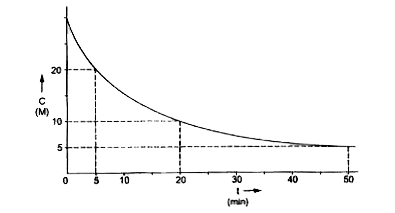In a first ordr reaction, reactant concentration 'C' varies with time 't' as
C decreases with 1t
log C decreases with 1t
1c increases linearly with t
log C decreases lineary with t
The correct Answer is:D
To solve the problem regarding how the reactant concentration 'C' varies with time 't' in a first-order reaction, we can follow these steps:
1. Understand the First-Order Reaction:
In a first-order reaction, the rate of reaction is directly proportional to the concentration of one reactant. The general form of the rate equation is:
Rate=−dCdt=kC
where k is the rate constant.
2. Integrate the Rate Equation:
Rearranging the rate equation gives:
dCC=−kdt
Integrating both sides, we get:
∫dCC=−k∫dt
This results in:
lnC=−kt+lnC0
where C0 is the initial concentration at time t=0.
3. Rearranging the Equation:
Exponentiating both sides gives:
C=C0e−kt
Alternatively, we can express it in logarithmic form:
lnC=lnC0−kt
4. Expressing in Logarithmic Form:
We can convert the natural logarithm to base 10 logarithm using the conversion factor lnx=2.303log10x:
log10C=log10C0−kt2.303
5. Identifying the Linear Relationship:
This equation can be rearranged to fit the linear equation format y=mx+b:
log10C=−k2.303t+log10C0
Here, y=log10C, m=−k2.303, x=t, and b=log10C0.
6. Conclusion:
From the linear relationship, we can conclude that as time t increases, log10C decreases linearly. Therefore, the concentration C decreases exponentially with time.
Final Answer:
The correct answer is that log10C decreases linearly with time t.
In a first-order reaction, the rate of reaction is directly proportional to the concentration of one reactant. The general form of the rate equation is:
Rate=−dCdt=kC
where k is the rate constant.
Rearranging the rate equation gives:
dCC=−kdt
Integrating both sides, we get:
∫dCC=−k∫dt
This results in:
lnC=−kt+lnC0
where C0 is the initial concentration at time t=0.
Exponentiating both sides gives:
C=C0e−kt
Alternatively, we can express it in logarithmic form:
lnC=lnC0−kt
We can convert the natural logarithm to base 10 logarithm using the conversion factor lnx=2.303log10x:
log10C=log10C0−kt2.303
This equation can be rearranged to fit the linear equation format y=mx+b:
log10C=−k2.303t+log10C0
Here, y=log10C, m=−k2.303, x=t, and b=log10C0.
From the linear relationship, we can conclude that as time t increases, log10C decreases linearly. Therefore, the concentration C decreases exponentially with time.
The correct answer is that log10C decreases linearly with time t.
Topper's Solved these Questions
- CHEMICAL KINETICS BOOK - MHTCET PREVIOUS YEAR PAPERS AND PRACTICE PAPERSCHAPTER - CHEMICAL KINETICS EXERCISE - Exercise 2
84 Videos
- CHEMICAL KINETICS BOOK - MHTCET PREVIOUS YEAR PAPERS AND PRACTICE PAPERSCHAPTER - CHEMICAL KINETICS EXERCISE - MHT CET CORNER
20 Videos
- CHEMICAL KINETICS BOOK - MHTCET PREVIOUS YEAR PAPERS AND PRACTICE PAPERSCHAPTER - CHEMICAL KINETICS EXERCISE - MHT CET CORNER
20 Videos
- BIOMOLECULES BOOK - MHTCET PREVIOUS YEAR PAPERS AND PRACTICE PAPERSCHAPTER - BIOMOLECULES EXERCISE - MHT CET CORNER
24 Videos
- CHEMICAL THERMODYNAMICS AND ENERGETICBOOK - MHTCET PREVIOUS YEAR PAPERS AND PRACTICE PAPERSCHAPTER - CHEMICAL THERMODYNAMICS AND ENERGETICEXERCISE - MHT CET Corner
40 Videos
Similar Questions
Knowledge Check
In a 1st order reaction, reactant concentration C varies with time t as:
A1/C increases linearly with tBlog C decreases linearly with tCC decreases with 1/tDlog C decreases with 1/tIn a 1st order reaction, reactant concentration C varies with time t as:
A1/C increases linearly with tBlog C decreases linearly with tCC decreases with 1/tDlog C decreases with 1/tIn a 1st order reaction, reactant concentration C varies with times t as:
A1C increase linearly with tBlogC decrease linearly with tCC decrease with 1tDlogC decrease with 1t
In a first order reaction fraction of the total concentration of the reactant varies with time 't' is equal to
View SolutionIn a first order reaction, the concentration of the reactants is reduced to 25% in one hour. The half-life periof of the reactions is
View SolutionIn a first order reaction, The concentration of reactant is reduced to 1/8th of the initial concentration in 75 minutea at 298 K. What is the half period of the reaction in minutes?
View SolutionIn a first order reaction, The concentration of reactant is reduced to 1/8th of the initial concentration in 75 minutea at 298 K. What is the half period of the reaction in minutes?
View SolutionIn a first order reaction with time the concentration of the reactant decreases
View Solution

